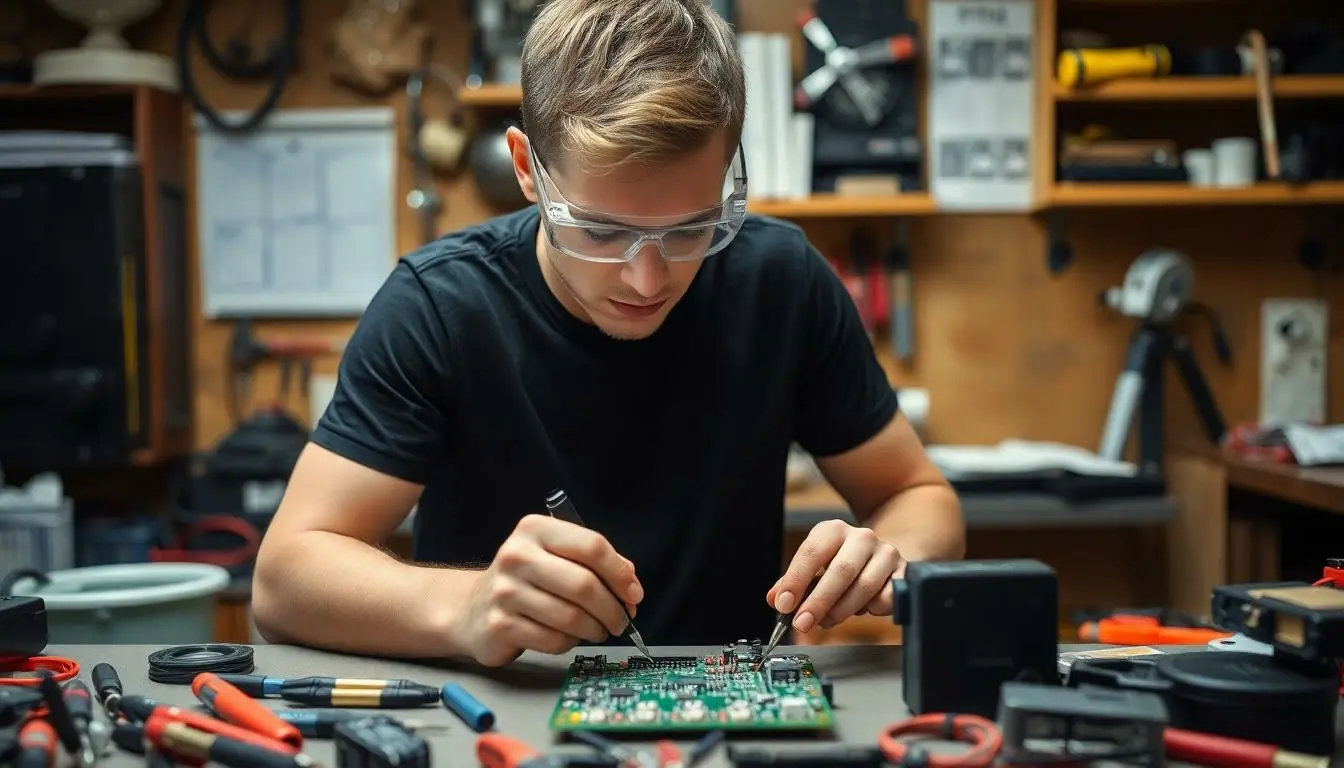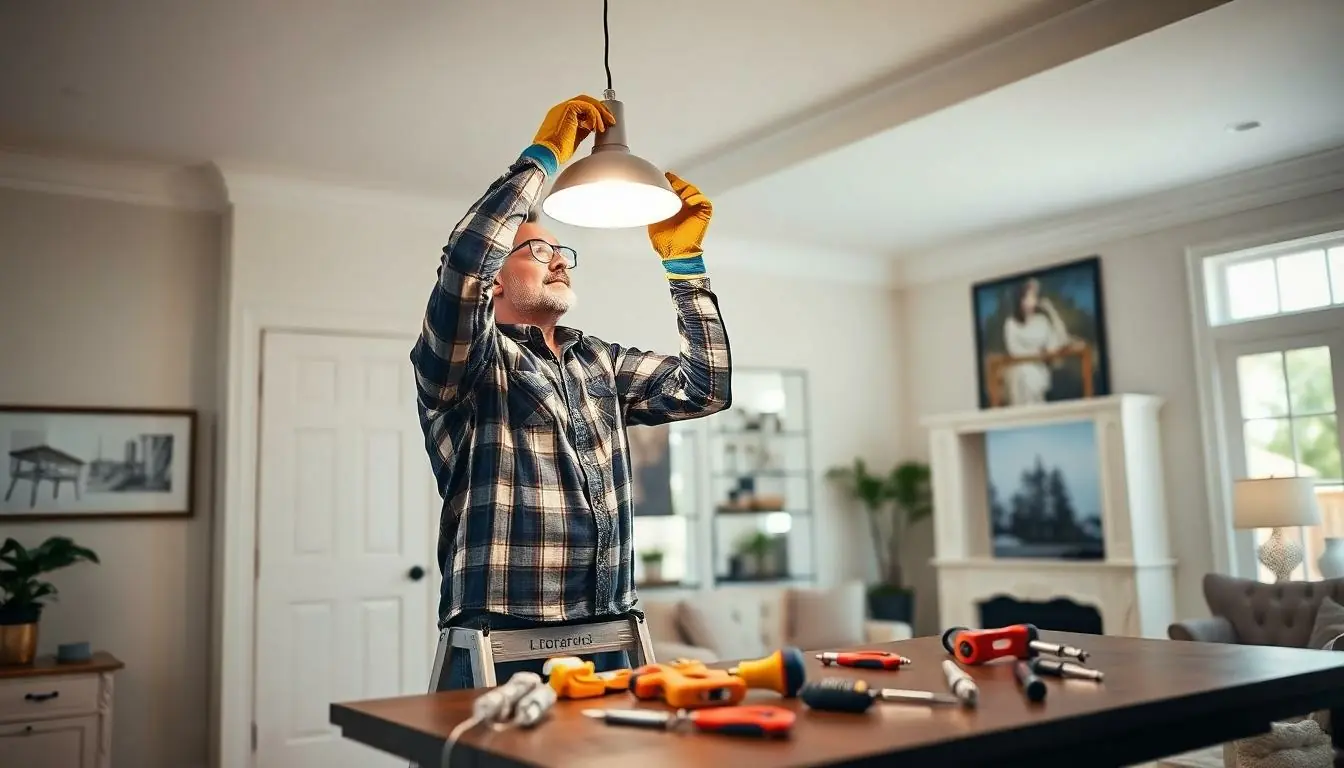Table of Contents
ToggleIn a world where gadgets seem to multiply faster than rabbits, DIY electronics projects offer a refreshing escape from the mundane. Imagine turning your living room into a mini-laboratory where creativity meets circuitry. Whether it’s building a quirky robot that delivers snacks or crafting a smart mirror that reflects your fabulousness, the possibilities are endless.
Overview of DIY Electronics Projects
DIY electronics projects offer a unique way for individuals to explore technology and creativity. Engaging in these projects enables creators to build customized solutions tailored to their needs. Common types include automated devices, wearable technology, and home automation systems. Individuals frequently leverage microcontrollers, such as Arduino and Raspberry Pi, to streamline the development process.
These projects encourage experimentation, helping enthusiasts learn valuable skills like soldering, coding, and circuit design. Satisfaction often comes from overcoming challenges and seeing ideas come to life. Many hobbyists share their experiences online, forming a vibrant community that fosters collaboration and inspiration. Through platforms like Instructables and GitHub, people access a wealth of resources and project ideas.
Time and budget constraints often influence project selection. Simple projects like LED blinkers require minimal investment, while advanced projects might involve more complex components and considerable effort. Participants can gain experience gradually, starting with basics and progressing to intricate designs.
Safety remains paramount when working with electronics. Identifying hazards ensures projects unfold without incidents. Utilizing protective equipment, such as goggles and gloves, enhances safety while building and testing circuits.
Exploring DIY electronics projects not only nurtures creativity but encourages continuous learning. Engaging in this field cultivates an understanding of both technology and problem-solving. Through participation, individuals develop skills that translate to various applications, fostering innovation and self-expression.
Benefits of DIY Electronics Projects

DIY electronics projects offer numerous advantages that enhance personal and professional development. Engaging in these projects fosters a deep understanding of technology while allowing for creativity.
Skill Development
Participating in DIY electronics projects builds critical skills. Learning soldering techniques proves valuable for circuit assembly. Understanding coding facilitates interaction with microcontrollers like Arduino. Experimenting with circuit design nurtures analytical thinking. Collaborating with others enhances teamwork abilities and expands knowledge sharing. Mastering troubleshooting techniques empowers individuals to find solutions quickly. Each project completed bolsters confidence and encourages further exploration.
Cost Efficiency
Undertaking DIY electronics projects provides significant cost savings. Building devices from scratch often costs less than purchasing ready-made alternatives. Sourcing components from local vendors reduces expenses compared to retail prices. Many hobbyists utilize recycled materials, minimizing waste and further lowering costs. Online resources provide free tutorials, cutting down on educational expenses. Building multiple projects encourages using leftover materials, promoting efficiency. Budget-conscious enthusiasts can achieve innovative results without large investments.
Popular DIY Electronics Projects
Exploring popular DIY electronics projects showcases the breadth of creativity and skill anyone can achieve. These projects cater to various experience levels, ensuring that everyone can find something intriguing.
Beginner Projects
Beginner projects offer simple yet rewarding experiences. Building an LED blink circuit introduces basic components like resistors and breadboards. Making a DIY USB charger provides practical skills and enhances understanding of power sources. Another engaging project is creating a sound-activated light, which incorporates sensors and amplifies circuit comprehension. Each beginner project builds confidence and lays the foundation for more complex tasks.
Intermediate Projects
Intermediate projects demand a bit more skill and innovation. Designing a temperature and humidity sensor leverages microcontrollers like Arduino, allowing users to engage with environmental data. Another popular option is building a simple robot, which fosters creativity in programming and mechanical design. A smart mirror, integrating displays and sensors, combines aesthetics with functionality, appealing to tech-savvy enthusiasts. Each intermediate project enhances technical proficiency and encourages problem-solving.
Advanced Projects
Advanced projects challenge even the most skilled hobbyists. Constructing a home automation system empowers users to control devices remotely, merging software and hardware seamlessly. Creating a wearable health monitor integrates sensors into fashion, expands knowledge of biomedical applications, and fosters innovation in personal technology. Developing a custom drone expands aerospace skills and enhances understanding of complex electronics. These advanced projects foster deep specialization and encourage the pursuit of cutting-edge technology.
Essential Tools and Materials
DIY electronics projects require specific tools and materials for successful execution. Knowing these essentials helps streamline the creative process.
Tools for DIY Electronics
Soldering irons are crucial for joining electronic components. Multimeters allow for measuring voltage, current, and resistance accurately. Wire strippers simplify preparing wires for connections. Pliers and tweezers assist with handling small components effectively. Additionally, a breadboard enables rapid prototyping without soldering. Safety goggles provide eye protection during project work. Finally, a toolbox organizes the tools, keeping everything easily accessible.
Recommended Materials
Resistors come in various values, providing essential functionality in circuits. Capacitors store and release energy, making them vital for timing applications. Diodes protect circuits from backflow. Transistors act as switches and amplifiers, facilitating more complex designs. Connecting wires link components, with jumper wires being particularly useful for temporary setups. Batteries serve as power sources, while power supplies offer adjustable voltage for testing. Lastly, enclosures protect finished projects, ensuring durability and safety.
Tips for Successful DIY Electronics Projects
Understanding project scope helps define the complexity. Start with smaller projects to build confidence and skills. Gathering tools and materials beforehand streamlines the process and minimizes frustration.
Researching project details promotes understanding and preparation. Online resources like Instructables and GitHub provide tutorials, schematics, and community support. Utilizing these platforms fosters creativity while learning from experienced hobbyists.
Planning the project layout ensures effective execution. Design a schematic that outlines connections and component placement. Effective planning reduces errors, saving time during assembly.
Testing components prevents problems later in the project. Verify functionality before integrating parts into the circuit. Regular testing ensures reliability and enhances troubleshooting skills.
Documenting the process captures learning experiences. Note any challenges faced and resolutions achieved. This documentation contributes to personal growth and can assist others facing similar issues.
Maintaining safety is crucial when working with electronics. Wearing safety goggles protects the eyes from debris. Additionally, working in a well-ventilated area reduces the risk of inhaling fumes from soldering.
Experimentation enhances creativity and problem-solving. Allow for flexibility and innovation, even if it diverges from standard methods. Embracing trial and error leads to unique solutions.
Building a community connection aids in project completion. Sharing successes and challenges with others fosters collaborative growth. Engaging with peers helps build relationships while enhancing knowledge and skills.
DIY electronics projects offer an exciting avenue for creativity and innovation. By blending technology with personal expression, individuals can transform their ideas into tangible realities. These projects not only enhance technical skills but also foster a sense of accomplishment and community among enthusiasts.
As hobbyists explore various levels of complexity, from beginner to advanced, they discover the joy of problem-solving and experimentation. The right tools and materials play a crucial role in this journey, ensuring smooth execution and successful outcomes.
Ultimately, engaging in DIY electronics nurtures a lifelong passion for learning and collaboration, paving the way for future innovations. Whether building simple circuits or complex systems, the possibilities are endless for those willing to dive into the world of DIY electronics.







